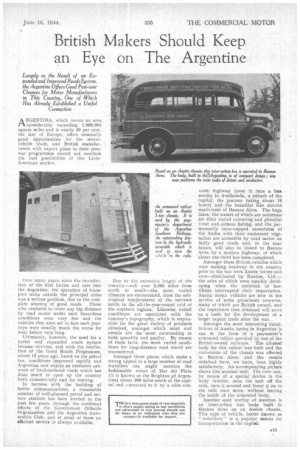British Makers Should Keep an Eye on The Argentine
Page 23

If you've noticed an error in this article please click here to report it so we can fix it.
ARGENTINA, which covers an area considerably exceeding 1,000,000 square miles and is nearly 30 per cent. the size of Europe, offers unusually good opportunities for the motorvehicle trade, and British manufacturers with export plans in their postwar programmes should not overlook the vast possibilities of this LatinAmerican market.
Over many years, since the introduction of the first lorries and cars into the Argentine, the operation of transport units outside the principal cities was a serious problem, due to the complete absence of good roads. Those who ventured to cover any big distance by road motor under such hazardous conditions were very few and the vehicles that were set to face such journeys were usually Much the worse for wear before very long.
Ultimately, however, the need for a better and expanded roads system became obvious, and with the institution of the Good Roads Programme, about 12 years ago, based on the petrol tax, conditions improved rapidly and Argentina now enjoys an extensive network of hard-surfaced roads which has done much to open up the country both commercially and for touring. In harness with the building of better communications, a reasonable number of well-planned petrol and service stations has been erected in the past few years, through the combined efforts of the Government Oilfields Organization and the Argentine Automobile Club, and at most of them an efficient service is lWays available. Due to the extensive length of the country—well over 2,000 miles from north to south—the most varied climates are encountered, from the subtropical temperatures of the extreme north to the all-the-year-round cold of the southern regions. Likewise, varied conditions are associated with the country's topography, which is responsible for the great variety of products obtained, amongst which meat and cereals are the most outstanding in both quantity and quality. By reason of these facts, the most varied conditions for long-distance road travel are encountered.
Amongst those places which make a strong appeal to a large number of road travellers one might mention the fashionable resort of Mar del Plata (it is known as the Brighton pf Argentina) about 300 miles south of the capital and connected to it by a wide con
crete highway (over it runs a bus service to Avellaneda, a suburb of the capital, the journey taking about 10 hours) and the beautiful lake district south-west of Buenos Aires. The huge lakes, the waters of which are notorious for their varied colouring and plentiful trout and salmon fishing, and the permanently snow-capped mountains of the Andes with their exuberant vegetation are accessible by road motor on fairly good roads and, in the near future, will also be linked to Buenos Aires by a modern highway, of which about one-third has been completed.
Amongst those British ,vehicles which were making headway in the , country prior to the war were Austin lorries and cars—distributed by Buxton, Ltd.— the sales of which were steadily developing when the outbreak of hostilities interrupted their importation, Austin motor vehicles are now in the service of some prominent concerns, many of which are British owned, and the experience thus obtained will serve • as a basis for the development of a larger export trade after the war, .
Amongst the most interesting installations of Austin lorries in Argentina is one in the form of a paymaster's armoured railcar operated by one of the British-owned railways. The all-steel body for-this railcar was built and the conversion of the chassis was effected in Buenos Aires, and the results obtained have, we learn, been highly satisfactory. An accompanying picture shows this unusual unit. The crew can, by means of a special device in the body interior, raise the unit off the rails, turn it around and lower it on to the rails once more, without leaving the inside of the armoured body.
Another -unit worthy of mention is an inter-urban bus body built in Buenos Aires on an Austin chassis. This type of vehicle, butter known as " colectivo," is a. popular means for transportation in the capital.




















































